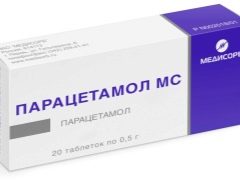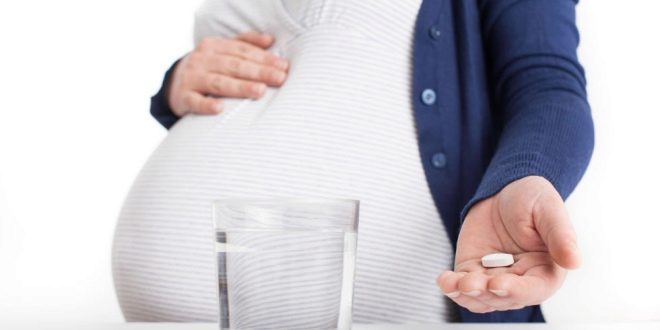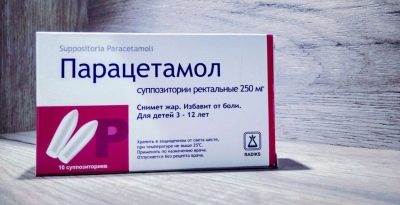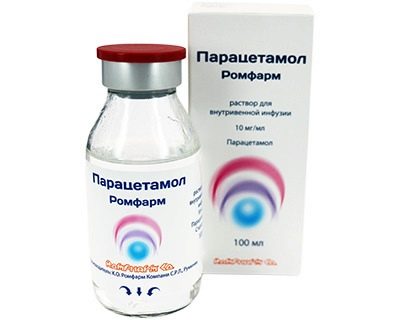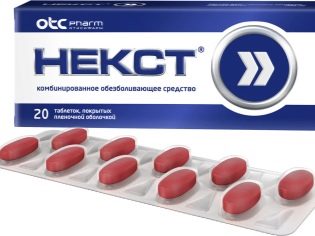"Paracetamol" during pregnancy: instructions for use
While waiting for the child to take any medication should be treated with caution. Therefore, when the expectant mother's temperature rises or headaches appear, she does not dare immediately drink antipyretic and analgesic drugs, for example, Paracetamol. And rightly so - before you eliminate the pain or bring the temperature down with a pill, you need to make sure that this medicine is safe for the body of the pregnant woman and the crumbs in the tummy.
Is pregnant allowed?
"Paracetamol" is one of the most popular symptomatic drugs prescribed for pain and fever. It is allowed even for infants and is considered the safest nonsteroidal anti-inflammatory agent in childhood. Instructions for the use of such a drug does not prohibit it during pregnancy, however, recommends that the expectant mother first consult a doctor.
According to experts, "Paracetamol" can be taken while carrying a child in situations where it is really necessary. For example, if the body temperature of a pregnant exceeded 38 degreesthen this is dangerous for the fetus. In this case, the use of "Paracetamol" is preferable to the effects of fever, which can adversely affect the baby.
If a woman has a bad tooth or headache, this is also bad for the baby in the womb, because it causes discomfort to the expectant mother and causes stress. In this situation, "Paracetamol" will be the best option for anesthetic.
Doctors believe that it would be better if a pregnant woman takes the dose prescribed by the doctor for this medication than she will continue to suffer and endure the pain.
Dosage Form
Paracetamol is produced by various pharmaceutical companies, so this drug is sold in all pharmacies, and without a prescription. It is represented by several species.
- Candles. This drug option is often chosen for infants or allergies, as it is easy to use in infants, and the only inactive substance of the suppository is a fatty basis. Candles themselves elongated, white-cream or white and packed in 10 pieces. They are recommended to be stored in the refrigerator, and the shelf life of such a drug is 2 years. Paracetamol dosage in one suppository is from 50 to 500 mg. The drug with a lower dose is used in children, and pregnant women are usually prescribed 500 mg suppositories.
- Suspension. This type of drug is more in demand in childhood, so on the package you can see the name "Paracetamol for children" or "Paracetamol for children." But in the absence of other forms at hand, such a drug can also be used by adults. The drug is sold in glass bottles, to which is attached a syringe with graduations or a measuring spoon. One bottle can hold from 100 to 200 g of yellowish or gray liquid smelling like orange or strawberry. The dosage of paracetamol in suspension is usually 120 mg per 5 milliliters.Store the sweet liquid is allowed at room temperature, and the shelf life of such a drug is often 3 years.
- Effervescent tablets. This form of Paracetamol is produced by Hemofarm. These tablets are usually large, round, white in color, and are sold for 10-40 pieces in plastic tubes. The dosage per 1 tablet is 500 mg. Shelf life of the drug - 2 years.
- Regular pills. This is the most popular type of “Paracetamol” in adults, as due to its small size it is easy to swallow, and one tablet contains a rather large single dose - 200 or 500 mg. The drug is sold in blisters of 10-20 or more pieces in a pack, and is usually characterized by a round shape and white color. The shelf life of such "Paracetamol" is the largest among all forms - 3-5 years.
- Injection. A clear liquid without color is sold in 50 or 100 ml polyethylene bottles, and is used as an emergency aid, therefore, Paracetamol is very rarely administered to pregnant women. Every milliliter of this medicine is a source of 10 mg of active substance.
Act
The active substance of the same name of any form of "Paracetamol" affects cyclooxygenase - special enzymes that are present in brain tissues, in particular, in the center of pain and in the area responsible for thermoregulation. Such a mechanism prevents the production of prostaglandins, as a result of which the pain sensations subside, and the increased body temperature returns to normal.
Similar enzymes are found outside the central nervous system, but they have a different type, and paracetamol has almost no effect on such cyclooxygenases. This is also facilitated by the presence in peripheral tissues of other enzymes, called cellular peroxidases. For this reason, "Paracetamol" has a very weak anti-inflammatory effect and does not provoke many adverse symptoms characteristic of analogues: water retention, damage to the gastric mucosa, and so on.
When can it be applied?
The most frequent indication for using Paracetamol for the expectant mother is the need to reduce body temperature if she has risen above +38 degrees. If the fever of the mother is strong and prolonged, it is more dangerous for the fetus than the possible side effect of the medication.
The result of an active inflammatory process are various developmental disorders of the baby, and in severe cases, the death of the baby in the womb. therefore if the pregnant woman has a cold, ARVI or flu, and the number on the thermometer grows threateningly, then Paracetamol is recommended to reduce body temperature.
No less in demand and the analgesic effect of "Paracetamol". The drug can be used for migraines, toothaches, burns, injuries, pains in the joints or muscles. It copes well with moderate and mild pain, but with severe pain may be ineffective.
Features of use
"Paracetamol" at different stages of pregnancy is not used equally, this must be considered before you prescribe yourself a drug.
In 1 trimester
This period is characterized by the active development of the fetus, so the body of the future baby can be affected by any adverse effects, which include drugs. It is during the first 13 weeks that the vital organs of the crumbs are formed, and the use of medications can provoke undesirable consequences. This also applies to Paracetamol.
Although the drug is considered relatively safe, there is still a small risk when taken, so in the first trimester it should be avoided if possible, for example, if the pain is not strong or the temperature is below +38 degrees. In rare cases, this medicine causes malformations or may even lead to miscarriage.
2 trimester
The middle of pregnancy is considered by doctors to be the most peaceful period, because the baby’s organs have already been formed, and the placenta protects him from many harmful substances.The use of "Paracetamol" from the 14th to the 27th week is allowed, and the risk of complications, according to experts, is minimal.
In 3 trimester
Unlike many analogues, Paracetamol does not harm the fetus in the last months of pregnancy. And if the future mother has a fever at 28 weeks or later, it is more dangerous than taking Paracetamol tablets, because the function of the placenta worsens during fever and the risk of fetal hypoxia and childbirth increases early. Only in very rare cases, the crumbs may be intolerant of the active substance of the drug, which will manifest itself in the future.
Contraindications
Reception "Paracetamol" is prohibited if the expectant mother is hypersensitive to any ingredient of the drug. Other contraindications for pregnancy include:
- ulcerative or erosive lesions of the stomach;
- bleeding from the digestive tract;
- the lack of glucose-6-phosphate dehydrogenase in the body.
They also advise pregnant women with kidney disease, bronchial asthma, liver disease, or blood disorders to refuse treatment with Paracetamol, as their risk of side effects of the drug increases.
Reception of suspension is prohibited if there are hereditary diseases in which the digestion of sugars is violated. The use of suppositories is contraindicated in diseases of the rectum.
Side effects
Sometimes the future mother's digestive system responds to Paracetamol with various dyspeptic symptoms, such as nausea or stomach discomfort. Occasionally, an allergic reaction to the drug in the form of urticaria, itching or skin rash occurs. Rare side effects of the drug also include its negative impact on blood formation and liver condition.
Dosage, frequency and duration
A single dose of "Paracetamol" for the future mother is best to check with the doctor. Often it is 500 mg, but in some cases (for example, with comorbidities), it can be much lower. In addition, with pain syndrome, it is recommended to start with half (200-250 mg) - perhaps this amount of the active substance will be enough to eliminate the pain.
Doctors call the maximum single dosage 1 g of paracetamol, and it cannot be taken more than 4 g per day. Optimal use of the drug only as needed - when the temperature is very high or the pain worries quite strongly.
Reception more than three times during one day is not recommended. As for the duration of use of "Paracetamol", it is limited to 3 days. Drinking such medication for prophylaxis is strictly prohibited.
Compatibility with other drugs
The effect of "Paracetamol" can affect different drugs. For example, if a pregnant woman takes a sorbent, it will affect bioavailability, so the analgesic and antipyretic effect will be weaker. The drug should not be combined with anticoagulants, anti-inflammatory drugs and some other drugs.
If the expectant mother needs to take, in addition to "Paracetamol", any other medications, medical consultation is required.
Reviews
Pregnant women who have taken Paracetamol for fever or pain speak about this medicine mostly well. Its advantages include a variety of dosage forms, safety for the fetus, therapeutic effect and good tolerance. Among the shortcomings mention that the drug begins to act not immediately, but only after 40-60 minutes, and after 3-4 hours the effect of Paracetamol disappears.
Analogs
If for some reason Paracetamol cannot be used, the expectant mother can replace it with medicine with a different name, but with the same active substance. These drugs include "Panadol", "Kalpol" and "Efferalgan". They are available in candles, suspensions, tablets, syrup and effervescent tablets.
You can also find drugs for sale, in which ascorbic acid, pheniramine, caffeine and other active compounds are added to paracetamol (Paracetamol Extra, Grippostad, Rinzasip, Coldrex, etc.). They are usually available in powder or effervescent tablets. Their reception during pregnancy is undesirable, so replace the usual drugs "Paracetamol" with these drugs.
In the first trimester, a pregnant woman can also use ibuprofen preparations for pain or fever, for example, "Nurofen". They can effectively replace "Paracetamol" in the second trimester, but in the last months of gestation, such antipyretic drugs are contraindicated, since they can affect the maturation of the cervix, the amount of amniotic fluid and the contractility of myometrium. The same restriction is also provided for analogues containing a combination of paracetamol and ibuprofen, for example, for the Next and Ibuklin tablets.
After reviewing all the information about the use of "Paracetamol" in the period of childbearing, we can briefly note the following:
- use it in 1 trimester undesirablebut in a dangerous situation is permissible;
- in the 2nd trimester to take the drug possible, but without abuse;
- In the last months of pregnancy, admission is not prohibited, but first you should consult a doctor.
See whether you can drink paracetamol during pregnancy in the next video.
